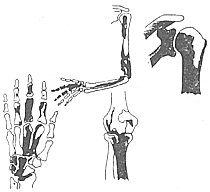| disease | Melorheostosis |
Melorheostosis, also known as candle bone disease, monomelic candle-like hyperostosis, and Leri's osteosclerosis, is a rare form of localized bone hyperplasia with a distinctive shape. On X-ray images, it resembles melted wax flowing down the bone shaft.
bubble_chart Etiology
It is a rare congenital developmental malformation, non-hereditary and without family history. The condition typically begins in childhood, affecting males and females equally. It usually involves a single limb, with the lower limbs being more commonly affected than the upper limbs.
bubble_chart Pathological Changes
Irregular sclerosis is observed due to the proliferation of the periosteal membrane and endosteal membrane. Microscopically, the hyperplastic bone area consists of dense lamellar bone with disordered arrangement, distorted Haversian canals, and interwoven immature and mature bone tissue. Osteoblast activity is increased while osteoclast activity is decreased, resulting in new bone formation. Other structures remain normal.
bubble_chart Clinical Manifestations
(1) Pain is the most common symptom, accounting for about half of the cases. The older the patient, the more pronounced the pain, which is generally described as dull pain or aching and worsens with activity.
(2) Restricted movement of the affected limb joints. This is caused by bone hyperplasia around the joints and bone deposition in soft tissues, rarely due to destruction of the joint surface.
(3) Bone deformity.
(4) Local palpation may reveal an uneven bone surface, hard as stone. Common manifestations include foot valgus, genu valgum, bone curvature, and knee joint enlargement.
(5) The affected limb may exhibit swelling, coldness, sweating, and the appearance of hard nodules. Some cases may also involve scleroderma, which is a manifestation of sympathetic nerve disorder and ischemia. Occasionally, hyperplastic bone tissue may be palpable.X-ray findings: The condition predominantly affects the long bones of the limbs, often in a single limb. Irregular bone hyperplasia is observed on one side of the diaphysis. The shape of the diaphysis is gradually disrupted, resembling molten wax flowing down the side of a burning candle. The hyperplastic bone lacks structure, and the epiphyses and short bones often appear speckled. The condition may extend beyond the joint to invade distal bone tissue but does not affect the joint surface. The pelvis and scapula also show increased density with speckled patterns, while the skull, spine, and ribs are rarely involved (Figure 1).

Figure 1: Melorheostosis presents as irregular longitudinal bone deposition, resembling flowing molten wax.
For typical cases, due to their distinctive manifestations, diagnosis is not difficult. Some cases need to be differentiated from the following diseases: osteopetrosis (marble bone disease), osteopoikilosis (spotted bone disease), fibrous dysplasia of bone, and inflammatory osteosclerosis.
bubble_chart Treatment Measures
There is no specific treatment for the cause of the disease. Some joint contractures and bone deformities can be corrected with orthopedic surgery.
The disease is progressive. It progresses rapidly during the developmental period and slows down in adulthood, but does not affect life expectancy.





